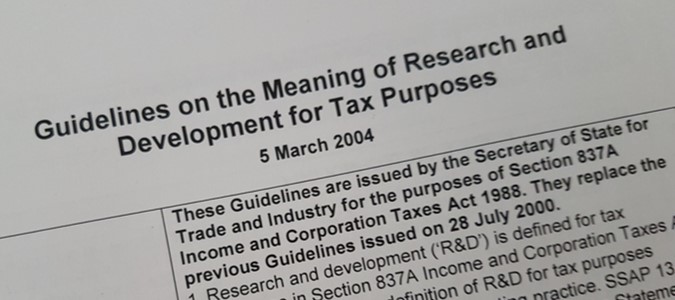R&D Tax Relief Eligibility Criteria

The software underpinning RDRelief was sold to one of the big-4 professional service firms in 2018. Consequently, the brand is no longer in operation.
- R&D Tax Advisors are invited to find out more about the Inspired.tax claim preparation software.
- Otherwise, please feel free to continue to browse this website for useful information regarding claiming R&D Tax Credits in the UK. However, beware that none of the information has been updated since 2018.
Contents
- Definition of R&D for Tax Purposes
- The BEIS Guidelines
- Scientific or Technological Advance
- Scientific or Technological Uncertainty
- 'Science' Defined
- 'Technology' Defined
- A Project for R&D Tax Purposes
- Advance in Overall Knowledge or Capability
- The Appreciable Improvement
- Directly Includable Activities
- Systems Uncertainty
- Qualifying Indirect Activities (QIAs)
- Project Start and End Dates
- Planning as Part of an R&D Project
- The Treatment for Abortive Projects
- Prototypes and Pilot Plants
- Design
- Cosmetic and Aesthetic Effects
- Content Delivered Through Science or Technology
- Eligibility Examples
Definition of R&D for Tax Purposes
R&D Tax Credits were introduced by the Government to stimulate the UK economy, support good quality job creation and promote economic growth. Although the government wants companies to claim R&D Tax Credits, they must be undertaking specific types of R&D Projects.
The UK Department for Business, Energy & Industrial Strategy has explicitly defined the types of projects that qualify through the release of their BEIS guidelines.
The BEIS Guidelines
The BEIS guidelines provide the official definition of R&D for tax purposes for each of the three UK R&D Tax Credit regimes (SME, RDEC and RDA).
At RD Relief we find that people often have preconceptions about what specific terms referenced within the guidelines mean, however, for R&D Tax Relief, the BEIS guidelines provide the definitive meaning. It is essential for all parties involved in an R&D Tax Credits claim to understand these official definitions (and if necessary, to put aside any
preconceptions), to correctly assess your R&D Tax Credits project.
These criteria are explored further within this article, but each section should be considered alongside the others for completeness.
Note: Sections highlighted in purple are the precise definitions taken directly from the governments BEIS guideline manual (external link).
R&D for Tax Purposes is defined within the BEIS guidelines as follows:
"R&D for tax purposes takes place when a project seeks to achieve an advance in science or technology."
"The activities which directly contribute to achieving this advance in science or technology through the resolution of scientific or technological uncertainty are R&D."
"Certain qualifying indirect activities related to the project are also R&D. Activities other than 'Qualifying Indirect Activities' which do not directly contribute to the resolution of the project's scientific or technological uncertainty are not R&D."
Scientific or Technological Advance
Main article: The Scientific or Technological Advance

The Scientific or Technological Advance needs to involve moving forwards from the current baseline of science or technology at an industry level. Hence, it could be developing a new, or appreciably improving an existing, system, process, material, device, product or service.
Deploying a known solution or configuring technology according to known principles would not qualify. However, if one of your competitors has achieved an advance which you are seeking, but they have not released details into the public domain, or you progressed without any knowledge of their activities, then the work you have undertaken can still qualify as R&D for Tax
Purposes.
Crucially, it is only the attempt to achieve the scientific or technological advance which is required, so if a project is cancelled (or does not continue for any other reason), then the costs incurred can still qualify.
Scientific or Technological Uncertainty
Main article: The Scientific or Technological Uncertainty

The Scientific or Technological Uncertainty can also manifest itself in various other forms. It may be that your company's competent professionals don't know whether it is even possible to achieve the advance or that they cannot readily deduce a solution using knowledge (or information) that is already readily available
in the public domain.
Thus, it might be that you don't know whether it is even possible to achieve the advance in practice or what the best way in practice would be.
Another common form of uncertainty is specifically referred to (within the BEIS guidelines) as 'Systems Uncertainty'. Systems Uncertainty is where the complexity of the project is at the systems level rather than at the individual component level. It is still important that the uncertainty be Scientific or Technological at this systems level, as HMRC will not accept Uncertainties that they see as a business, commercial or purely functional challenge.
'Science' Defined
Main article: Science Defined for R&D Tax Credits

Science is a crucial term within the R&D Tax guidelines - for which it is especially worth forgetting any pre-conceptions. Through the BEIS guidelines, the government have clearly defined Science to be the systematic study of the nature and behaviour of the physical and material universe.
Unfortunately for many companies, economics, social science, humanities and Maths have all been explicitly excluded from an R&D Tax Credits Claim. In the case of Maths, you can include Mathematical techniques used in the pursuit of a Scientific or Technological advance. However, Mathematics is never R&D in its own right.
'Technology' Defined
Main article: Technology Defined for R&D Tax Credits

As with the 'Science' definition above, pre-existing conceptions regarding the definition of 'Technology' can contradict HMRC's official guidance and result in a rejection of the claim. Hence, it is important to understand HMRC's official definition from the BEIS guidelines.
The BEIS definition of 'Technology' specifies the practical application of knowledge and principles from science (as defined above).
This definition is especially important as we often find it to be contrary to the common belief amongst our clients. Essentially it means that for companies to be undertaking projects that qualify for R&D Tax Credits, they must be working with knowledge and principles from Science, which in turn means that application of technology to a business problem (where no scientific
insight is required), would need to be excluded from any claim.
A Project for R&D Tax Purposes
Main article: An R&D Project

In the majority of cases, the scope of your company's Project for R&D Tax Purposes will be different from your Project for business purposes.
The BEIS definition of a project only includes the Scientific and Technological aspects (that are required to overcome the associated Scientific or Technological Uncertainty of the Project), whereas your business project may contain commercial concerns, functional analysis, support, maintenance and other costs that are not qualifying for R&D Tax Credits.
It may be that the project, as defined by your company, needs to be split into parts when assessing its R&D eligibility, or that the project should be combined with other overlapping 'sub-projects' when considering the implications of the R&D Tax Credits claim.
Advance in Overall Knowledge or Capability
Main article: An Advance in Overall Knowledge or Capability

The Scientific or Technological Advance needs to be relative to the current baseline of overall knowledge or capability. Thus a company cannot claim for a project which is applying industry standard techniques (even if they are new to your company), or where technology is being used to overcome a business or commercial problem.
If other companies have (or are attempting) to achieve a similar Advance, your project can still qualify - so long as you are working without their knowledge (or capability).
The Appreciable Improvement
Main article: Appreciable Improvement Definition

HMRC have defined an appreciable improvement to be the circumstance in which the scientific or technological characteristics of the 'result' are made better in such a way that would constitute more than just a minor change
As with the other subjective assessments required by the BEIS guidelines, this needs to be assessed by a competent professional working in the field, who will need to regard the work as a non-trivial scientific or technological improvement.
Importantly, an appreciable improvement cannot be the application of existing technology to a different business domain (unless there is significant technological change).
Directly Includable Activities
Main article: Directly Includable Activities

After identification of the Project's Advance and Uncertainty, it is time to think about which costs can be included.
Activities that contribute to overcoming Scientific or Technological Uncertainty can be included in the claim. It is of paramount importance to the claim's quantification to ensure the correct identification of the projects start and end dates.
It is often the case that new uncertainties become apparent at different points in the project and where this is the case the R&D process may start again. However, there needs to be a clear distinction between problems involving scientific and technological uncertainties and routine maintenance.
Systems Uncertainty
Main article: Systems Uncertainty

Systems Uncertainty is a specific type of uncertainty directly referenced by the BEIS guidelines concerning the complexity of a whole system, rather than its components.
An example of this in a Software Development project could be the Uncertainty of developing new low-latency trading algorithms that bring together low-level libraries in an undefined way. The Uncertainty would be how to overcome the performance overheads of integrating the disparate parts.
Alternatively, in an electronic engineering project, Systems Uncertainty could be encountered through the development of new types of circuits and devices, which leverage standard chips, but have never before been brought together in the way proposed.
Qualifying Indirect Activities (QIAs)
Main article: 'Qualifying Indirect Activities'

In addition to the directly qualifying activities, HMRC has defined 'Qualifying Indirect Activities' (QIAs) - additional tasks that can qualify on an R&D project.
Only costs explicitly stated within the list of QIAs, as defined by the government, can be included within an R&D Tax Credits claim. For the avoidance of doubt, if the activities you are considering are not listed, and they do not directly contribute to the resolution of technological uncertainty (as described above), then they cannot be included in the R&D Tax Credits
claim.
The full list of allowed QIAs includes feasibility studies, specific R&D training and the creation of reports containing the findings of an R&D project.
Project Start and End Dates
Main article: Project Start and End Date

It is crucial to accurately define the start and end dates for R&D on your projects, to ensure the robust preparation of an R&D Tax Credits Claim.
The R&D project commences when the team start working to resolve the uncertainty (hence gathering requirements would typically be seen as being before the start of the R&D claim period). The R&D project ends when this work ceases.
It is often the case that after the R&D period has ended, new Scientific or Technological Uncertainties manifest themselves (often when developing extensions to the original R&D). Consequently, additional R&D may be required and so the start of a new R&D claim period would commence.
Planning as Part of an R&D Project

Earlier in the guidelines, it was specified that activities that directly contribute to the resolution of scientific or technological uncertainty could be included within an R&D Tax Credits claim. The 'directly contributing' rule also applies to activities required for project planning - such as defining Scientific or Technological feasibility, identifying Scientific or Technological uncertainties, evaluating development time, detailed planning and management.
Activities not contributing to the resolution of Scientific or Technological Uncertainty must be excluded. For example, this might be the market analysis, financial or legal aspects of a project.
The Treatment for Abortive Projects
Main article: Aborted R&D Projects

Success is not a requirement for a project to qualify as R&D for tax purposes. An R&D project can be eligible whether the failure cause was technical, commercial or any other business reason. Should the project be cancelled for scientific or technological reasons, this can be somewhat indicative of technological uncertainty and thus can increase the justification of a project
qualifying.
Costs for attempting to overcome the Scientific or Technological Uncertainty are still allowable on cancelled projects - up to the point the Project terminated.
Prototypes and Pilot Plants
Main article: Prototypes and Pilot Plants

Prototypes and Pilot Plants are often undertaken to overcome the scientific or technological uncertainty of a problem. By this definition, Prototypes and Pilot Plants are generally developed to create something new and overcome Scientifically or Technologically Uncertain issues early in the development pipeline.
Once the scientific or technological uncertainty has been resolved (or has otherwise ceased to continue), the prototypes and pilot plants will no longer be R&D for tax purposes.
If further work to redesign the prototypes and pilot plants or they are in any other way significantly modified, and it is technologically uncertain how to achieve the changes, a new period of R&D may commence.
Design
Main article: Claiming Design in an R&D Tax Credit Claim

Most R&D projects involve undertaking design in some form - be it graphical, technical or any other number of other types of design.
Assessing the eligibility of the design activities can, however, be tricky - however, be tricky - as design, must always be part of overcoming the scientific or technological uncertainty of the project.
The requirement for the activities to be linked to overcoming project uncertainty is the same as the general eligibility criteria for an R&D Tax Credits project (despite the eligibility criteria issuing specific guidelines for design).
For example, if you are technically designing the mechanics of a type of valve, then this is likely to qualify, but if you are graphically working through the look and feel of a new user interface, then this is unlikely to qualify.
Cosmetic and Aesthetic Effects

Like other forms of design, most R&D projects will contain 'Cosmetic and Aesthetic effects', however, whether or not these will qualify as R&D for Tax Purposes can sometimes be complicated.
By default, RD Relief recommends that these types of activities should be excluded from your claim, as HMRC will see them as 'look and feel' problems, rather than scientific or technological advances.
However, this is not always the case and so in that case that Technology (or Science) is being developed to solve an Aesthetic or Cosmetic problem, then this could qualify as R&D for Tax Purposes.
For example, in software development, if you are changing the look and feel of a website, it probably would not qualify, but if you are creating a new JavaScript framework to be able to render the graphics of the site in a new way, then this makes the project eligible.
Content Delivered Through Science or Technology
Main article: Content Delivered Through Science or Technology

R&D projects delivered through science or technology are commonplace. It can be challenging in many cases to ascertain whether these projects also represent an 'Advance in Science or Technology'.
It could be the case that a project is extending an existing technology, but the crucial test (for the project to be classified as R& for Tax Purposes) is whether scientific techniques were applied to appreciably improve upon the baseline of knowledge or capability in the underlying field of science of technology.
Thus, if the project is singularly solving a business (or commercial) problem through the use of science or technology, this will not qualify as R&D.
Eligibility Examples
Based on examples from HMRC, the following explains the principles of the BEIS guidelines presented above. It is important to note that these are just examples and should be used as a guide only.
RD Relief has also produced a directory of information about the common types of R&D that occurs in different industries.
The R&D Process

Where a company undertakes market research to understand what design characteristics a new Blu-ray player should have to appeal to potential customers, this is not research and development for tax purposes. However, it may identify the need for an R&D Tax Credits project to create an appreciably improved Blu-ray player with various technological improvements which the company's R&D team consider to be non-trivial. This project would, therefore, be seeking to achieve an advance in technology.
Should the company then create a detailed specification and plan for developing the new device, then some elements of these would likely contribute to the resolution of Scientific or Technological Uncertainty. These elements are R&D for Tax Purposes (for example the uncertainty of developing an improved control mechanism for the laser that reads the disk). The other parts of the plan may consider business or cosmetic decisions and would not be R&D for tax purposes.
New prototype devices, until a final version - with all the required technical characteristics from the final product (e.g. performance and heat capacity) would be included. All of the activities which directly contributed to creating and testing these prototypes would be considered R&D.
Several copies of the final prototype may then be made and distributed for user testing. Neither the creation of these prototypes nor the user testing would be considered to be R&D. Some users may, however, log issues (e.g. noise level and functionality). Should the changes be more than a routine improvement and new technological uncertainty encountered then, it will be R&D for tax purposes.
Equal applicability in any branch of Science or Technology

The BEIS Guidelines (as described above) apply to all fields of Science and Technology in equal measure. As an example, software development is subject to the same R&D eligibility criteria as work in manufacturing, or pharmaceuticals.
This definition of equal applicability also applies to the methods used to resolve Scientific or Technological Uncertainty. For example, in some cases, a company could create a similar computing functionality in hardware or software. As long as the Technological (or Scientific) Uncertainty is not readily deducible by a Competent Professional working in the field, either approach to the development of the functionality could equally qualify for R&D Tax Credits.
Abortive Projects

Unfortunately, every project is not successful, and many do not achieve the Advance in Science or Technology that they initially sought. It may be that work to insert a gene into a specific sequence fails, or the attempt to increase the life of a battery may only yield a marginal improvement. In both cases, the project had initially sought to achieve an advance in Science or Technology and the work that had already been undertaken to resolve the Scientific or Technological Uncertainty would still qualify as R&D for Tax Purposes.
Advance in Science or Technology

Attempting to find the chemical structures of new drugs would typically be an Advance in Science, where the team tries to derive a new or appreciably improved compound, based upon the application of existing knowledge of Science (around the physiological effects of different compounds). The project would qualify, whether or not the method used to achieve the advance is entirely routine in itself. The activities that directly contribute to overcoming the associated Technological Uncertainty are R&D for Tax purposes. Any further work to identify new uses of existing compounds would also seek new Scientific knowledge about the molecules and would also be R&D for Tax purposes.
The development of software to analyse market data (but is not R&D in its own right), would not be R&D. This rule equally applies to other types of software not required as part of overcoming the broader project Technological Uncertainty, such as software to analyse sales forecasts.
The Advance in Science or Technology does not need to represent an absolute improvement (e.g. in the performance of a material, device or system). E.g. the existence of a Kettle with a superior boiling time does not prevent a project to create a lower boiling time Kettle from being an Advance in Technology. This scenario may apply if the new project developed the device to have a lower cost through the more efficient design of circuit design or construction.
Scientific or Technological Uncertainty

An Advance in Science or Technology may involve researching a new active ingredient for a bathroom cleaning product and developing a new formula that will incorporate the active ingredient for use in a commercial product. These two parts to the project would both represent an Advance in Science or Technology.
Achieving this Advance may require the team to undertake an investigation to extract likely ingredients. This investigation may require undertaking testing of the possible products using existing software. Although this would be using established knowledge and capability, it would have been adopted to tackle the specific R&D problem by testing and evaluating the bathroom cleaning product performance based upon various particular factors, and so would classify as R&D for Tax Purposes.
Where the company also works to investigate what characteristics the new product should have to appeal to customers, this would not directly contribute to the resolution of Scientific or Technological Uncertainty, nor would be a 'Qualifying Indirect Activity' (QIA). It would therefore no qualify for R&D Tax Credits.
